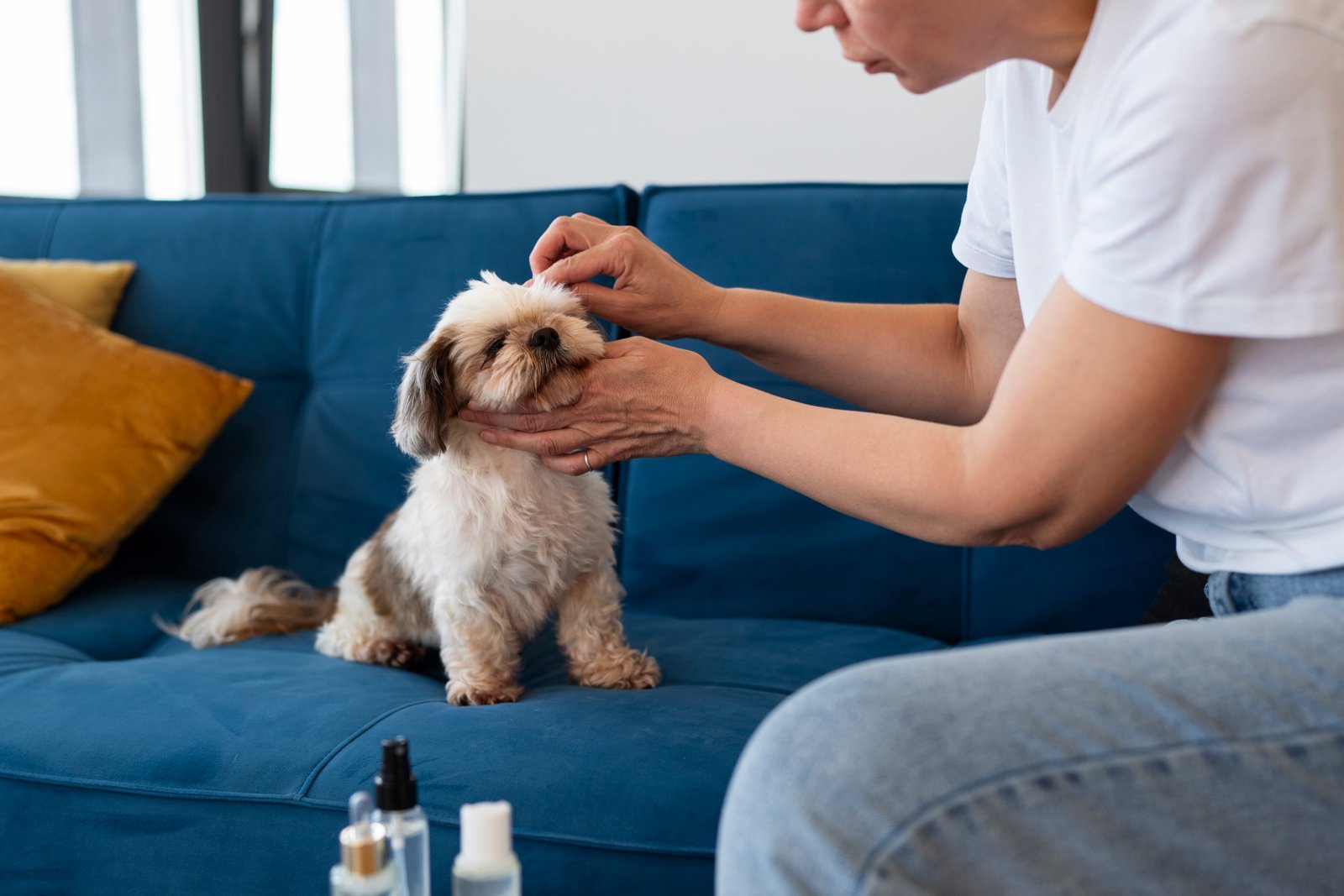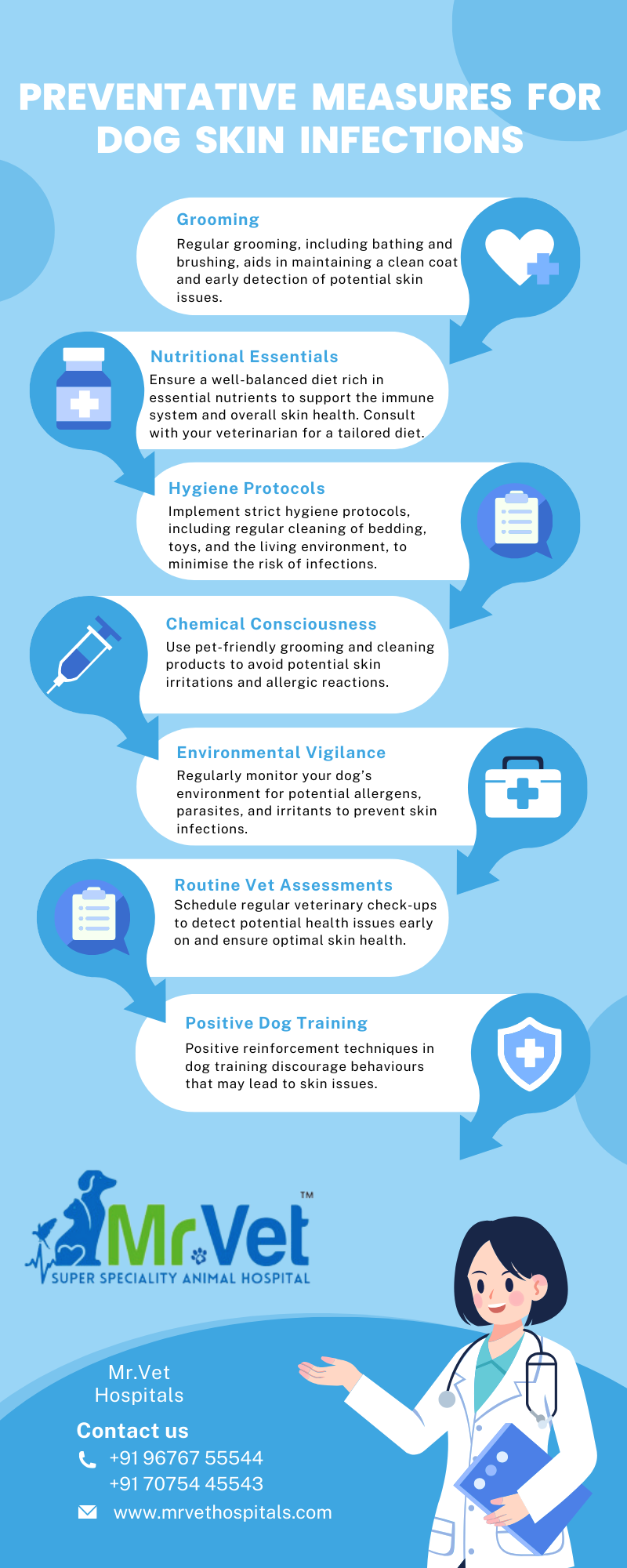
Common Symptoms of Dog Skin Infections:
1. Inflammation Alert:
- What it is: Inflammation is the body’s natural response to injury or irritation. In the case of skin infections, the inflamed area will appear red, swollen, and may feel warm to the touch.
- Why it matters: Inflammation is a warning sign that something is wrong. Promptly identifying and addressing inflamed skin helps prevent further damage and discomfort for your dog. If the inflammation is left untreated, it can worsen the infection and lead to secondary issues like open sores or scarring.
2. Pustules and Bumps Clues:
- What they are: Pustules are small, pimple-like bumps filled with pus, a white or yellow fluid containing dead white blood cells and bacteria. Other bumps might appear solid and red.
- Why they matter: The presence of pustules and bumps is a strong indicator of a microbial infection, either bacterial or fungal. Understanding the type of bumps can help your veterinarian diagnose the specific cause and recommend the most effective treatment plan. For example, bacterial infections typically involve pus-filled bumps, while fungal infections might present with dry, scaly bumps.
3. Hair Loss Red Flags:
- What it is: Unexplained hair loss, especially in patches, is a common symptom of various skin problems in dogs. The hair loss might be localized to a specific area or spread throughout the body.
- Why it matters: Hair loss is a red flag that shouldn’t be ignored. Recognizing the pattern of hair loss can help pinpoint the root cause of the infection. For instance, patchy hair loss can be a sign of mites or ringworm, while generalized hair loss might be linked to allergies or hormonal imbalances. Consulting a veterinarian to diagnose the underlying cause is crucial for addressing the hair loss and preventing further issues.
4. Distressed Ears:
-
- What it is: Dogs often communicate discomfort through their ears. Constant scratching at the ears, head shaking, or an unusual ear odor could indicate an ear infection, which can be a symptom of underlying skin problems.
- Why it matters: Monitoring your dog’s ears and addressing any signs of distress is essential for their overall skin health. Ear infections can be a source of irritation and discomfort, and they can also spread to other parts of the body if left untreated. By regularly checking your dog’s ears and seeking veterinary attention if necessary, you can prevent the infection from worsening and maintain their overall skin health.
Causes of Dog Skin Infections:
1. Flea and Tick Troubles:
These tiny pests don’t just cause itching and discomfort – their bites can trigger allergic reactions in your dog’s skin, leading to inflammation, redness, and even infections. Fleas can also transmit diseases, making regular preventative measures like flea and tick medication crucial for your dog’s overall health and to prevent skin problems.
2. Sneaky Allergies:
Dogs can develop allergies to various things, including food, pollen, dust mites, and even certain shampoos. Sometimes, these allergies manifest as skin infections. If your dog has recurring skin problems, consult your veterinarian to identify potential allergens through testing. Eliminating these allergens from your dog’s environment becomes key to long-term management of their skin health.
3. Mites and Mange Awareness:
Microscopic mites burrowing into your dog’s skin can cause a condition called mange. There are different types of mange, each caused by a specific mite. Understanding the lifecycle of these mites is crucial for effective treatment and prevention. Consult your vet if you suspect a mite infestation, as they can diagnose the specific type of mange and recommend the appropriate treatment plan.
4. Hormonal Imbalance Impact:
Hormonal imbalances, especially in older dogs, can contribute to skin issues. Conditions like hypothyroidism or Cushing’s disease can affect your dog’s skin health. Regular veterinary check-ups are essential for identifying and managing hormonal imbalances early on. Early intervention can help prevent or minimize skin problems associated with these conditions.
What to Do if You See Signs of Skin Infection:
1. Quick Care:
If you notice signs of a skin infection, like redness, itching, or hot spots, act quickly. Provide immediate care by gently cleaning the affected areas with a mild, pet-friendly shampoo or antiseptic solution recommended by your veterinarian. This can help soothe the discomfort and prevent further irritation.
2. Vet Consultation:
Don’t delay! Prompt consultation with a veterinarian is essential for an accurate diagnosis and tailored treatment plan. The vet may recommend diagnostic tests like skin scrapings or cytology to identify the specific pathogen causing the infection. Early diagnosis and treatment ensure a faster recovery for your furry friend.
3. Emotional Support:
Skin infections can be very uncomfortable for dogs. Recognize the discomfort your pet is experiencing. Shower them with extra love, attention, and gentle handling to reduce stress and anxiety during the healing process. Creating a calm and supportive environment can aid in their recovery.
Preventative Measures for Dog Skin Infections:
1. Grooming Strategy:
Regular grooming, including brushing and bathing, is your first line of defense against skin infections. Brushing removes dirt, dead hair, and potential allergens, while bathing with a gentle pet shampoo keeps your dog’s coat clean and healthy. Regular grooming also allows for early detection of potential skin problems like rashes or bumps.
2. Nutritional Essentials:
A well-balanced diet rich in essential fatty acids, vitamins, and minerals is vital for maintaining healthy skin and a strong immune system. Consult your veterinarian for a personalized diet plan that caters to your dog’s breed, age, and activity level. A healthy diet helps your dog’s body fight off infections and promotes overall skin health.
3. Hygiene Protocols:
Maintaining good hygiene is crucial in preventing the spread of bacteria and other pathogens that can cause skin infections. Regularly clean your dog’s bedding, toys, and their living environment to minimize the risk of infections. Washing your hands after handling your dog, especially if they have a skin infection, is also a good practice.
4. Chemical Consciousness:
Always use pet-friendly grooming and cleaning products on your dog. Harsh chemicals in human products can irritate your dog’s skin and trigger allergic reactions that could lead to infections. Opt for gentle shampoos and conditioners formulated specifically for dogs.
5. Environmental Vigilance:
Keep an eye on your dog’s environment for potential allergens, parasites, and irritants. If you live in an area with a lot of fleas or ticks, be extra vigilant about preventative measures. Similarly, identify and minimize exposure to any environmental allergens that may trigger skin problems in your dog.
6. Routine Vet Assessments:
Schedule regular veterinary check-ups for your dog, even if they seem healthy. These check-ups allow your veterinarian to detect potential health issues, including skin problems, early on. Early detection and intervention can often prevent minor skin concerns from escalating into more serious infections.
7. Positive Dog Training:
Positive reinforcement techniques in dog training can be helpful in preventing behaviors that might contribute to skin problems. For example, excessive licking or chewing at itchy areas can worsen skin infections. Training your dog alternative behaviors and providing them with appropriate chew toys can help reduce these behaviors.
Additional Causes of Dog Skin Infections:
- Bacterial Infections: These can occur when bacteria invade broken skin or areas with compromised defenses. Scratches, wounds, or insect bites can create entry points for bacteria.
- Fungal Infections: Fungal infections, like ringworm, are caused by microscopic fungi that thrive in warm, moist environments. They can be highly contagious and require specific treatment.
- Yeast Infections: An overgrowth of yeast naturally present on your dog’s skin can lead to yeast infections. These are often triggered by underlying conditions like allergies or hormonal imbalances.
Signs and Symptoms of Dog Skin Infections:
- Itching: This is the most common symptom and can range from mild to severe. Excessive scratching can lead to hair loss, open sores, and secondary infections.
- Redness and Inflammation: Inflamed skin appears red, swollen, and may feel warm to the touch.
- Hair Loss: Patchy or generalized hair loss can occur in areas affected by the infection.
- Scabs and Crusts: These may form on the surface of the skin due to scratching or drying of pus from the infection.
- Hot Spots: These are localized areas of intense inflammation, redness, and pain that can appear suddenly.
- Unpleasant Odor: Skin infections often have a distinct odor, which can be yeasty or foul-smelling.
Treatment Options for Dog Skin Infections:
The specific treatment for a dog skin infection depends on the underlying cause. Treatment options may include:
- Antibiotics: For bacterial infections, your veterinarian may prescribe oral or topical antibiotics.
- Antifungal Medications: Fungal infections require antifungal medications applied topically or taken orally.
- Antiparasitic Medications: For flea, tick, or mite infestations, specific medications like spot treatments or oral medications will be recommended.
- Medicated Shampoos and Sprays: Topical medicated shampoos or sprays can help soothe irritated skin and reduce inflammation.
- Antihistamines: These medications can help manage itching associated with allergies or skin infections.
- Dietary Changes: Modifying your dog’s diet, especially if allergies are suspected, can be a crucial part of long-term management.
- Supplements: Omega-3 fatty acid supplements can help improve skin health and reduce inflammation.
Conclusion:
Maintaining healthy skin is vital for your dog’s overall well-being. By understanding the causes of skin infections, recognizing the signs, and implementing preventive measures, you can help your furry friend stay healthy and comfortable. Remember, early diagnosis and treatment are key to a speedy recovery. If you notice any signs of a skin infection, don’t hesitate to consult your veterinarian.
Click here to know more about pet’s health care tips.

